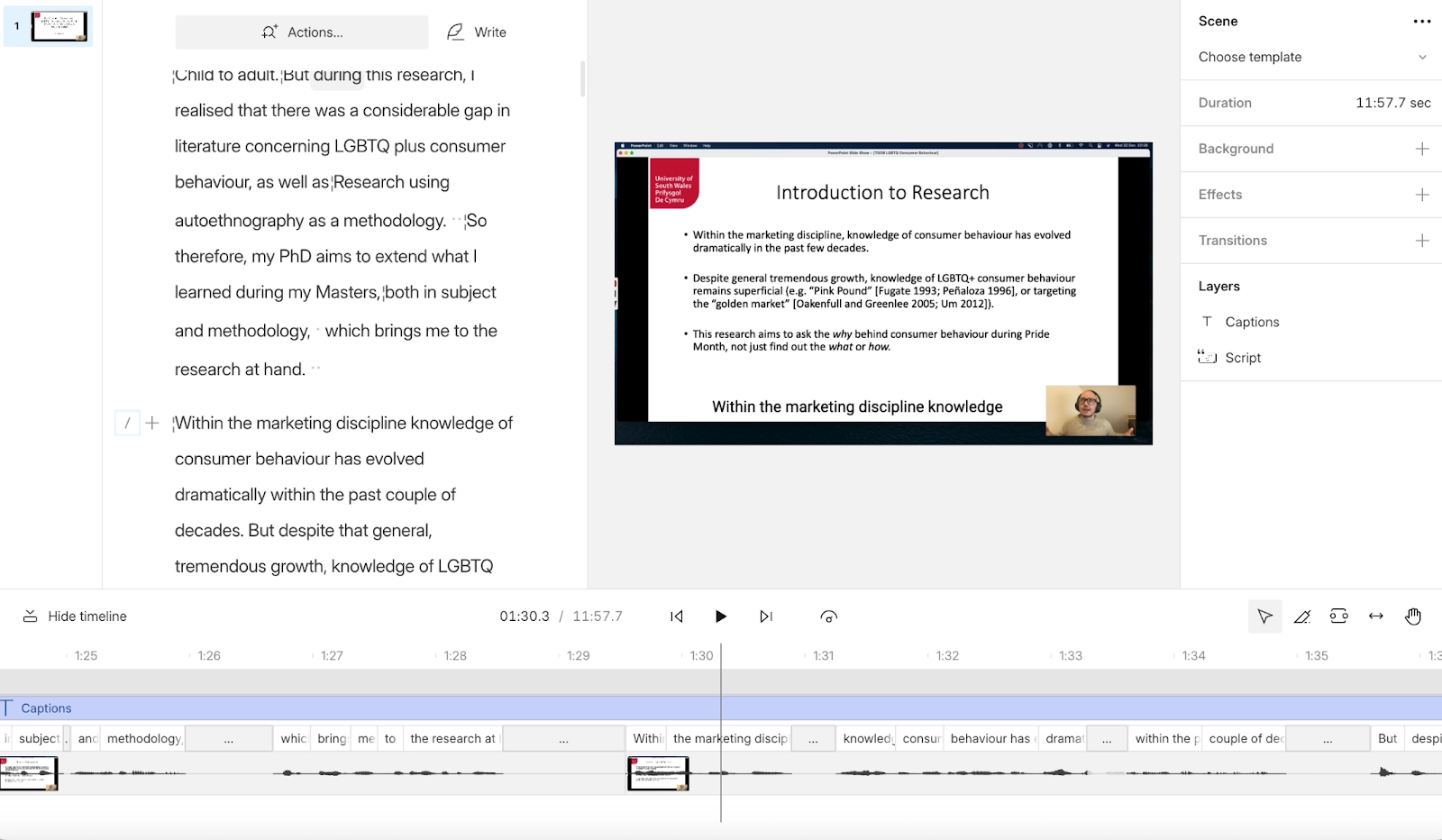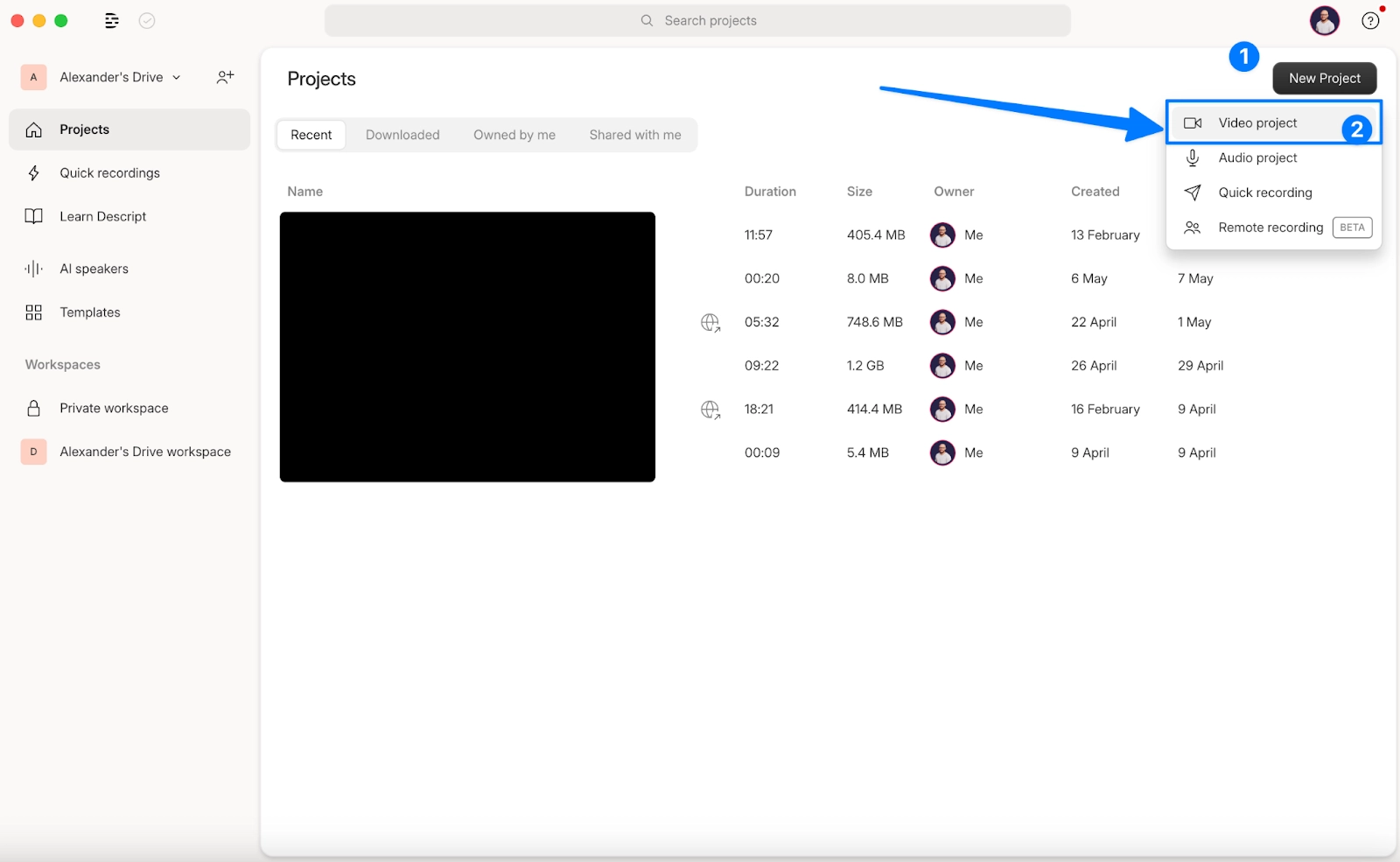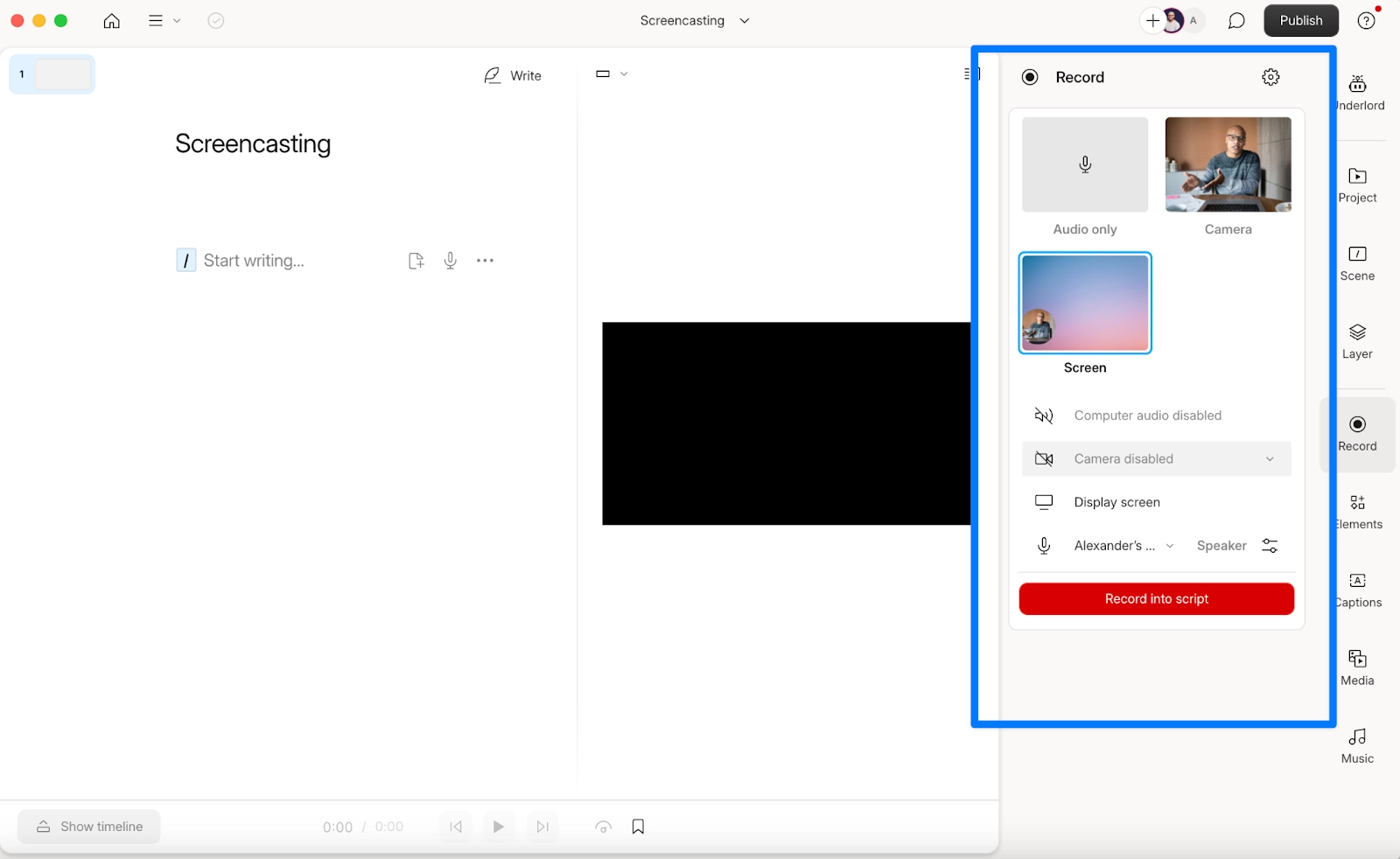If you've ever had colleagues ask you multiple times about how to use a particular work software and had to explain each time what to do — I feel your frustration (it's happened to me). On the other hand, maybe you're good at a particular computer program and you want to share some tips to help others.
What you'll be looking to create is a screencast video recording.
So, in this guide, we'll take you through the basic concept of screencasting including what it is, why you might use it, when to use it, and how to make one with screencast software.
Don't worry, it's all pretty straightforward.
What is a screencast?
A screencast is a recording that captures the visual and audio activity happening on your computer screen.
If you've ever watched a software tutorial on YouTube for example, it was most likely a screencast — for example, Descript has a video tutorial for how to record using Descript:
But essentially, if you're using your computer to do the thing, then you can screencast it (which is yes, basically another word for screen recording).
Why use screencasting?
If you relate to the introduction scenarios, chances are you have an intuitive sense of why screencasting is so useful. However, we'll just spell out the benefits in case you're doubtful.
Screencasts are easy to make
Of all the different types of video content you can create, screencasts are probably the easiest. You don't need fancy cameras and you don't even need the best microphones on the market (although a good microphone would be a pretty nice boost for the recording quality.
All you need is software that records your screen and some kind of microphone (most laptops these days come with one built-in).
As you'll see in the step-by-step tutorial further on in the guide, the process itself is also very straightforward.
They provide helpful audio and video context
Have you ever tried to explain a (computer-based) process and said "Ah, it's hard to explain without showing you"? Screencasts are potentially the most useful types of videos to help you with "show don't tell."
That's because they show exactly what's happening on your screen as you explain the context of what's happening. Your viewers can then follow along or at least have a good idea of what they can do using a similar process.
Viewers can control the playback
For the viewers, screencasts are beneficial because they can pause, rewind, and rewatch the video over and over again. The screencast becomes a reusable resource that they can revisit whenever they need to.
So, instead of explaining a process or sharing your knowledge multiple times, screencasts help you share your knowledge at scale.
These aren't the only benefits of creating screencasts, but they're some of the most obvious. So, when does a screencast come in handy? Let's check out a few use cases below.
When to use screencasts
Screencasts are a super versatile video format, simply because all you're doing is recording your screen. Whatever you can do on a computer, you can record a screencast of it. So, let's take a look at some of the most popular uses for screencasts.
Tutorials
Perhaps the most obvious use case is for tutorial videos since you can easily show how to do what you're doing in any particular software. Lots of creators use screencasts to create tutorial content — and often shift between recording their screen, themselves, and both at the same time.
For example, one of my favorite YouTube creators, Thomas Frank, uses screencasts all the time to give Notion tutorials and explainers:
Training videos
Screencasts are also great if you're a working professional since you can use them for internal knowledge bases to help train other members of staff or for onboarding them.
You might not be able to anticipate where staff may need support, but since screencasts are so easy to make, you can create them when the need arises on top of your existing content library.
I had some experience with this while working in the financial sector, and with this experience, I can give you one important tip — make sure you avoid recording confidential information (whether it's the company's or its customer's information). If the video library was leaked or hacked in any way, you may end up on the wrong side of several data protection laws.
Video lessons
In an educational setting, screencasts such as video lessons or recorded lectures can help you mimic the experience of the teacher lecturing with a (maybe interactive) whiteboard. In this case, it's a better idea to include your face in the recording to help build rapport with learners.
Screencast video lessons have become significantly more popular since the pandemic, and many educators still use them for a hybrid learning approach and to help students catch up on missed classes.
Presentations
Finally, similar to video lessons, you can also create screencast presentation videos — which you can use in content creation, workplaces, and the education sector.
As a PhD candidate, I've used Descript to make a few screencast presentation videos for presenting research at conferences:

However, screencast presentations make for great YouTube content on a variety of topics from fitness, pet care, history, technology, and more (just ask yourself what topic you could talk about for more than a few minutes, and you could make a screencast presentation on it).
How to make a screencast
- Prepare
- Open up Descript and check your settings
- Start recording
- Finish recording and edit
- Share your screencast
As I mentioned towards the beginning of this guide, creating a screencast is one of the easiest types of videos to make (with the exception of recording a video from your Android/iPhone or a "point and shoot" camera).
There are technically only four simple steps for creating a screencast, but I've included a fifth step because I presume you'll want to share it with at least one other person.
Step 1: Prepare
The first step you'll need to take is preparation. Even if you know the process you're recording like the back of your hand, it's still quite easy to make mistakes when you're recording.
To help reduce the potential of mistakes, write a script for your screencast to keep you on track and to help you move smoothly through your tutorial, training video, presentation, or whichever type of content you're recording.
But don't worry about getting everything exactly right. Since Descript makes it super easy to edit your video content, you don't need to worry about getting perfect takes.
You'll also want to make sure that if you're recording a presentation, you have it ready on the window you'd like to record from.
Here are a few other checklist items to help you prep for a screencast recording:
- Make sure you have notifications turned off and all unnecessary tabs/windows closed to avoid potentially embarrassing reveals.
- Check that you’ve chosen the right camera for recording, if you have an external one, it might default to your webcam.
- Try setting up your recording session in a quiet environment — noise-canceling effects and microphones can help, but it's a good idea to not rely too heavily on them.
- Also, double-check your physical background for items you don't want people to see (unless you plan to use a green screen effect or not use your face at all).
Step 2: Open up Descript and check your settings
There are a few screen recording software tools available, especially as alternatives for Loom, though naturally, we'd recommend downloading Descript if you haven't already.
Once you have signed up for Descript, either open the app or the browser version and create a new video project:

From there you'll have a few options on the script panel; the one you want to choose is "Record". Don't worry, it won't start recording right away. Instead, you'll see the recording settings pop up on the right-hand side.
Double-check these settings, especially if you want to screen record with audio narration.

In these settings, you'll be able to change whether you want your camera on or not which window you want to record (if you have multiple monitors, this one is important), as well as the audio input source.
Step 3: Start recording
Once you're sure the settings are correct and you've got the content you want to record ready, all you need to do is start recording. Choose the option to "Record into script" and a small pop up message will ask you to drag a box over the area of the screen you want to record, or press Space to record the whole screen.
After you've chosen the area of your recording, Descript will give you a countdown and begin recording.
Step 4: Finish recording and edit
When you come to the end of your content, simply press the red square "stop" icon or Stop recording (depending on your settings). From there, Descript will automatically start transcribing your recording — if you're on the free plan, you get one hour of free transcription per month.
However, you can now start video editing your screencast. Some useful features that will help speed up the editing process are Remove Filler Words (to get rid of those um's and uh's), Studio Sound to help give it high-quality audio, and AI Overdub to help you avoid going back to re-record over a mistake.
But if you're stuck, here's a quick video for some screen recording tips:
Step 5: Share your screencast
After you've edited your screencast, all you need to do to share it is to click the Publish button in the top-right corner of the screen:

A small box will pop up to help you share your video on the platform of your choice — alternatively, you can download the video to your computer and share it manually.
Use Descript for your screencasts
Whether you're a video production pro or a beginner just getting started, screencasts are always a viable option for sharing knowledge with other people. They're easy to make, great at providing context, and are a reusable resource for anyone who needs them.
Whether you're a creator or a working professional, Descript is a video editor that can help you create snappy screencasts to get your point or message across.
Try Descript for you or your team today to see just how easy it is.
Screencast FAQs
Are screencasts and videos the same thing?
It might sound that way, but it's not quite true — all screencasts are videos, but not all videos are screencasts.
How can I share screencasts?
In Descript, you can share your screencast in just a few clicks by hitting Publish and choosing the platform you want to share it on (or via a Descript-hosted web link).
How do I edit a screencast?
Editing a screencast is as simple or complex as you want to make it — some simple editing tips include removing any filler words you might have recorded (um's and uh's) as well as any lengthy pauses. Otherwise, you can also add transitional effects, annotations, music, animations, and more.



























%20(1).JPG)






